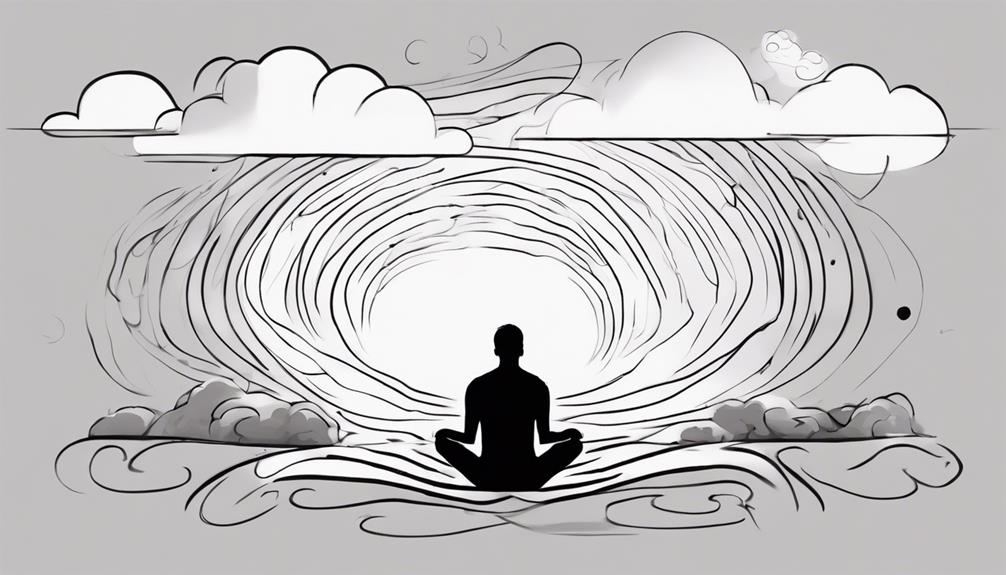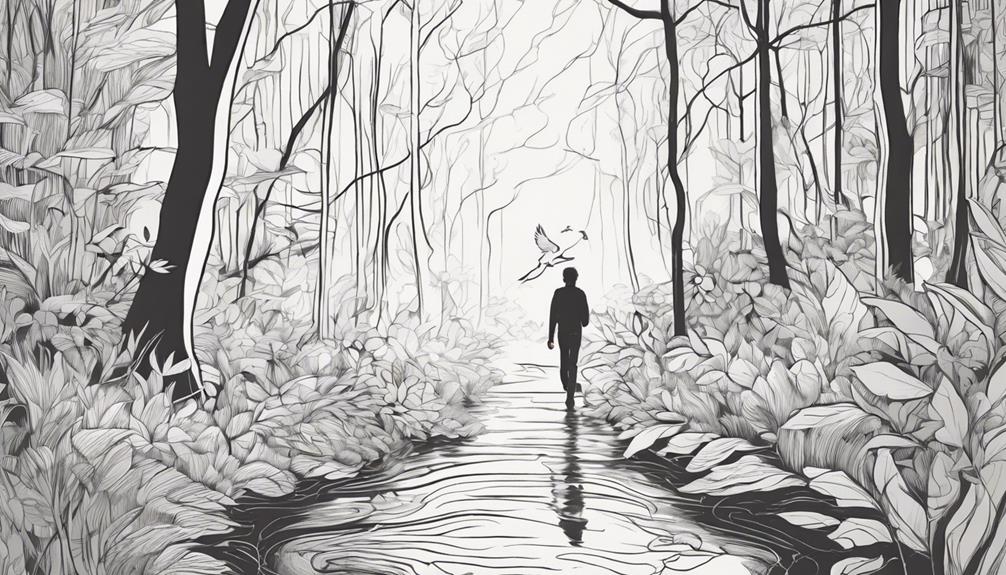Navigating the complex terrain of fear and anxiety requires a methodical approach that encompasses self-awareness, strategic coping mechanisms, and a support network. Understanding the underlying causes and triggers of these emotions sets the stage for effective intervention. By honing relaxation techniques, challenging distorted thoughts, and gradually confronting feared scenarios, individuals can begin to dismantle the grip of fear and anxiety. However, the journey to overcoming these formidable adversaries is multifaceted, requiring a blend of psychological strategies and emotional resilience. Stay tuned to uncover the intricate web of strategies that hold the key to conquering fear and anxiety.
Key Takeaways
- Practice deep breathing and mindfulness techniques to reduce fear and anxiety.
- Engage in nature therapy to lower stress levels and promote peace of mind.
- Utilize positive imagery and visualization to reshape perceptions and diminish fear.
- Seek support from friends, family, and professionals to manage fear and anxiety effectively.
Understanding Fear and Anxiety

Understanding fear and anxiety involves recognizing the distinction between these two emotional states and their physiological and psychological manifestations. Fear is a natural response to immediate threats, triggering a fight-or-flight reaction to protect oneself. On the other hand, anxiety is characterized by persistent worry and apprehension, often concerning future events or outcomes. While fear is typically linked to a specific trigger, anxiety can arise from non-threatening situations and linger over time, impacting mental health.
Symptoms of fear and anxiety overlap, including increased heart rate, muscle tension, and difficulty concentrating. Prolonged anxiety can lead to irritability, headaches, and other physical and mental health issues. Individuals experiencing overwhelming fear responses that persist over time may be diagnosed with anxiety disorders, which can significantly affect daily functioning.
Treatment options for anxiety disorders often involve Cognitive Behavioral Therapy (CBT) to address maladaptive thought patterns and behaviors. By understanding the nature of fear and anxiety and seeking appropriate interventions, individuals can learn to manage and overcome these challenging emotions for improved mental well-being.
Differentiating Fear and Anxiety
Fear and anxiety, although often intertwined, can be distinguished by their unique triggers and responses in the human body. Fear is typically a response to immediate and real threats, activating the body's fight-or-flight response. On the other hand, anxiety is frequently associated with perceived or imagined threats, leading to a state of persistent worry and high alertness. While fear is more focused on the present danger, anxiety tends to revolve around future uncertainties, making it a more mental and abstract concept.
To help differentiate between fear and anxiety, let's look at a comparison table:
| Aspect | Fear | Anxiety |
|---|---|---|
| Triggers | Immediate, real threats | Perceived or imagined threats |
| Duration | Short-lived | Persistent |
| Response | Fight-or-flight response | Chronic state of high alertness |
| Nature | Reactive | Proactive |
| Coping Strategies | Addressing current danger | Managing worries and uncertainties |
Understanding these distinctions can aid individuals in developing targeted coping mechanisms for dealing with everyday anxiety problems effectively.
Effects of Fear and Anxiety

Fear and anxiety have tangible effects on both physical and mental health, including increased heart rate, muscle weakness, irritability, and difficulty concentrating. These symptoms can persist and impact daily functioning, necessitating effective coping strategies to manage the effects of fear and anxiety on overall well-being. Understanding the physiological and psychological repercussions of fear and anxiety is essential for individuals to develop resilience and overcome these challenges.
Impact on Health
The physiological and psychological impacts of fear and anxiety on the body are well-documented and can manifest in various physical and mental symptoms. Fear and anxiety can lead to physical effects such as a fast heart rate, irregular heartbeat, muscle weakness, and excessive sweating. On the mental side, individuals may experience difficulty concentrating and feelings of dizziness. Long-term anxiety symptoms may include irritability and headaches. These responses to fear and anxiety can significantly impact overall health and well-being. Managing fear and anxiety is crucial in preventing the development of long-term health issues.
| Physical Effects | Mental Effects |
|---|---|
| Fast heart rate | Difficulty concentrating |
| Irregular heartbeat | Dizziness |
| Muscle weakness | – |
| Excessive sweating | – |
| – | Irritability and headaches |
Coping Strategies
Understanding the impact of fear and anxiety on both physical and mental health is crucial for developing effective coping strategies. Fear and anxiety can manifest physically through symptoms like a fast heart rate, muscle weakness, and excessive sweating, while mental effects may include difficulty concentrating, irritability, and headaches. Long-term anxiety can significantly affect mental health, leading to challenges in daily functioning and overall well-being. To cope with anxiety, individuals can employ various strategies such as exercise, relaxation techniques, and maintaining healthy eating habits. These coping mechanisms can help manage anxiety levels and overcome fear by addressing both the physical and mental aspects of anxiety. By recognizing and addressing these effects, individuals can work towards improving their overall well-being and quality of life.
Overcoming Fear With Imagination
Utilizing the power of imagination to overcome fear involves visualizing calming scenes, harnessing creative visualization techniques, and cultivating positive mental images. These methods can help reframe fearful thoughts, reduce anxiety levels, and instill a sense of tranquility. By engaging in positive imagery exercises, individuals can build confidence, resilience, and a more optimistic outlook when facing their fears.
Visualize Calming Scenes
How can visualizing calming scenes through imagination effectively aid in overcoming fear and anxiety? By using the power of imagination to visualize serene environments, individuals can reduce anxiety levels and promote a sense of calmness. Creating mental images of peaceful settings triggers the body's relaxation response, counteracting fearful thoughts and emotions. The act of visualizing soothing scenarios is a potent tool for managing fear and anxiety, allowing individuals to immerse themselves in positive experiences that help alleviate stress. Imagining oneself in tranquil surroundings can significantly impact mental well-being by providing a mental escape from distressing situations, fostering a sense of peace, and ultimately empowering individuals to confront their fears with a heightened sense of control and composure.
Harness Creative Visualization
Harnessing creative visualization techniques offers a powerful strategy for overcoming fear and anxiety through the utilization of imagination. Creative visualization involves imagining positive outcomes to combat anxious thoughts and emotions. Visualization techniques can help desensitize fear triggers and reduce anxiety responses effectively. Utilizing imagination to rehearse successful scenarios can boost confidence in facing fears head-on. Visualizing calm and peaceful scenes serves as a potent method for managing anxious thoughts and emotions. Ultimately, creative visualization proves to be a valuable tool in reshaping perceptions and diminishing the impact of fear and anxiety.
Use Positive Mental Images
Imagining positive mental images represents a powerful cognitive tool for individuals seeking to overcome fear and anxiety through the transformative potential of imagination. By envisioning positive outcomes and creating mental images of success, one can effectively reduce fear and anxiety levels. Visualization of calming scenarios offers a reprieve from anxious thoughts, shifting the focus from fear to feelings of empowerment. This technique not only provides relief but also boosts confidence in facing fears head-on. When individuals use their imagination to picture themselves overcoming challenges, it can significantly increase motivation to confront their fears. Ultimately, the use of positive mental images serves as a valuable strategy in combating fear and anxiety, harnessing the mind's ability to influence emotional states positively.
Breathing Techniques for Anxiety
When faced with anxiety, utilizing specific breathing techniques can effectively regulate physiological responses and alleviate symptoms. Deep breathing is an essential tool in managing anxiety levels as it helps calm the body physically and reduce feelings of stress. Anxiety often manifests through short, shallow breaths, but intentional deep breathing can counteract this pattern. Exhaling for a longer duration than inhaling can particularly benefit the nervous system during anxious moments, promoting a sense of relaxation and calm. By controlling breathing patterns, individuals can proactively prevent anxiety attacks and foster a state of relaxation in stressful situations. Incorporating deep breathing exercises into daily routines is a proactive approach to managing anxiety symptoms and promoting overall well-being.
- Deep breathing calms the body physically and reduces anxiety levels.
- Short, shallow breaths associated with anxiety can be controlled through intentional deep breathing.
- Exhaling longer than inhaling benefits the nervous system during anxious moments.
- Controlling breathing patterns helps prevent anxiety attacks and promotes relaxation.
- Daily deep breathing exercises aid in managing anxiety symptoms and well-being.
Mindfulness Practices for Fear

Utilizing mindfulness practices is integral in addressing fear and anxiety by fostering present-moment awareness and enhancing emotional regulation. Mindfulness techniques, such as deep breathing and body scans, play a crucial role in reducing fear and anxiety by promoting relaxation and aiding in emotional regulation. By being fully present in the moment, individuals can identify and acknowledge fearful thoughts without judgment, allowing them to respond to these thoughts in a more constructive manner.
Research suggests that mindfulness meditation can decrease the activation of the brain's fear center, thereby reducing anxiety levels. Integrating mindfulness into daily routines can enhance self-awareness and help individuals remain calm during fearful situations. By incorporating mindfulness practices, individuals can cultivate a greater sense of control over their emotions and reactions, ultimately leading to a reduction in fear and anxiety. Regular practice of mindfulness can empower individuals to navigate moments of fear with increased resilience and composure.
Seeking Support for Anxiety
Support networks play a crucial role in providing valuable insights and coping strategies for individuals managing anxiety. Seeking support for anxiety can come in various forms, each offering unique benefits:
- Friends, Family, and Professionals: Seeking guidance from trusted individuals can offer different perspectives and emotional support in dealing with anxiety.
- Support Groups: Joining support groups can create a sense of belonging and understanding, alleviating feelings of isolation and fear often associated with anxiety.
- Therapy Options: Cognitive Behavioral Therapy (CBT) and counseling provide structured approaches to identifying and managing anxiety triggers, equipping individuals with effective coping mechanisms.
- Emotional Relief: Sharing fears and concerns with others can reduce their intensity, offering a sense of relief and validation.
- Coaching and Counseling: Seeking help from coaches or counselors can aid in mastering skills to overcome anxiety, leading to improved mental well-being and resilience.
Nature Therapy for Fear

Immersing oneself in natural environments as a form of therapy has been increasingly recognized for its effectiveness in alleviating fear and anxiety symptoms. Nature therapy involves spending time in natural settings to reduce stress levels and improve overall mood. Engaging in physical activities amidst natural environments can help individuals shift their focus from irrational thoughts to the present moment, promoting relaxation, calmness, and clearer thinking. The beauty of natural surroundings plays a significant role in reducing anxiety symptoms and fostering a sense of peace and tranquility. By connecting with the natural world, individuals undergoing nature therapy can experience a decrease in fear and anxiety levels. Below is a table highlighting the key benefits of nature therapy in combating fear and anxiety:
| Benefits of Nature Therapy |
|---|
| Reduces stress levels |
| Improves mood |
| Promotes relaxation |
Nature therapy offers a holistic approach to addressing fear and anxiety, emphasizing the importance of the environment in enhancing mental well-being.
Promoting Self-Compassion in Anxiety
Research has consistently demonstrated the significant impact of practicing self-compassion in reducing anxiety and promoting emotional well-being. Self-compassion involves treating oneself with kindness and understanding during anxious moments. This approach includes recognizing the common humanity in anxiety experiences, fostering connection and support. Practicing self-compassion in anxiety entails using gentle self-talk and acknowledging emotions without judgment. Cultivating self-compassion in anxiety can enhance resilience, self-esteem, and overall mental health.
Incorporating self-compassion techniques in anxiety management can lead to a more compassionate and understanding relationship with oneself. By embracing self-kindness and acknowledging that experiencing anxiety is a shared human experience, individuals can navigate their fears with greater ease. This approach promotes emotional well-being by reducing the harsh self-criticism often associated with anxiety. Through self-compassion, individuals can build a foundation of support and understanding that aids in overcoming fear and anxiety more effectively.
Frequently Asked Questions
How Can I Train My Mind to Overcome Fear?
To train your mind to overcome fear, incorporate mindfulness techniques, positive affirmations, breathing exercises, cognitive restructuring, and visualization practices. These methods help rewire the brain's responses to fear triggers, promoting a more balanced and calm state of mind. By consistently practicing these strategies, individuals can develop resilience and reduce the impact of fear and anxiety on their daily lives. Professional guidance can further enhance the effectiveness of these tools in managing fear.
How Do I Get Rid of My Fear Completely?
To get rid of fear completely, a comprehensive approach incorporating fear management strategies is essential. Utilizing exposure therapy gradually desensitizes individuals to feared stimuli. Incorporating mindfulness practices aids in anxiety reduction, while cognitive-behavioral techniques help in identifying and challenging negative thought patterns. Building confidence through support networks and engaging in physical activities can further bolster resilience against fear. Consistent implementation of these strategies can lead to successful fear eradication.
Why Am I so Scared of Everything?
Excessive fear, rooted in anxiety triggers, can often originate from childhood trauma, shaping one's perceptions and responses to various stimuli. Understanding why one is scared of everything involves exploring past experiences and their impact on current emotions. Coping mechanisms, therapy options, and self-care practices can provide avenues for addressing and managing these fears effectively. Seeking professional help and support can aid in navigating and overcoming intense feelings of fear.
How Do I Stop Being Scared of Humans?
To stop being scared of humans, focus on building trust through positive social interactions. Boost self-confidence by gradually exposing yourself to human interactions and practicing mindfulness techniques. Consider seeking therapy to address underlying causes of fear. Challenge negative thoughts by replacing them with positive experiences. Utilize exposure therapy to desensitize yourself to fear triggers. Remember, overcoming fear is a gradual process that requires patience and persistence.
Conclusion
In conclusion, overcoming fear and anxiety requires a multi-faceted approach that includes understanding the nature of these emotions, utilizing relaxation techniques, seeking support, and practicing self-awareness. One interesting statistic to note is that approximately 40 million adults in the United States, or 18.1% of the population, are affected by anxiety disorders each year. By implementing these strategies and seeking help when needed, individuals can effectively manage and conquer their fears and anxieties.
